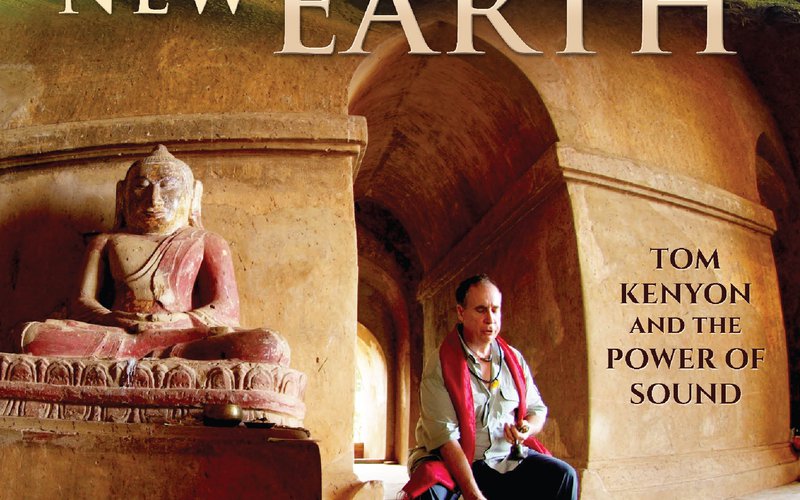
Song of the New Earth(Directed by Ward Serrill, USA, 2014, 89 minutes)
One day, a man named Tom received a question from someone, or something, from the planet Venus through unknown dimensions. He was asked if he could sing a song of the new earth to save lost human souls. Kenyon hopes to be a person who guides lost souls into the light with music and songs.
Ward Serrill's new documentary is about Tom Kenyon, a musician who lives in Orcas Island and gives spiritual workshops and psychotherapy using music and sound. His music is built with a backbone of his own experiences and studies in Religion, Psychology, and Acoustic Sound Research. His instruments are the Singing Bowl, bells, drums, and his voice. In his live performance footage, Kenyon displays many interesting sounds and music through these instruments and through his unique mixture of voice and song and his animal spirit sounds. Eastern monk-style throat singing and the Singing Bowl creates humming tones for the music, accentuated with bells and washed over with his voice imitating a humpback whale calling. This piece, with hand drums, reminds us of American Indian songs. He uses his voice not only a conventional way but can imitate any animal sound, as if he was possessed by its spirit. He says, “Use the voice to heal ourselves and others by how we speak words we choose, tonality we choose.”
His obsession with the use of echo effects is another instrument to expand his music and its dimensions. His music creates soothing calming effects to guide his audiences and clients in reaching a deeper state of consciousness. Sound and music are powerful aids to create this perfect ambiance for his workshop audiences.
Kenyon agrees that what he is revealing is very bizarre and that he is taking a big risk by talking about his visions. His story is so out there it will keep testing most viewers to think he is a crazy new age musician. In other words, a musician who has made one too many trips to another dimension and corrupted his brain while transporting. However, he supports his strange life experiences with stories with clear logic and sciences without forgetting the self-awareness that his stories are very strange. The clever use of animation is a great help to us in order to follow his stories at least with reasonable skepticism. Kenyon states, “For me, music and sound are both the language and underlying architecture of the cosmos.”
When he was about five, he remembers reading a book, The Boy Sang To The World. In this book, his dream come true when the boy sings. But the book never existed. Turns out, he was reading it in another realm of consciousness and the boy was himself. Kenyon grew up singing to the world that he was surrounded by, the sun, the stars, the trees. He knew they could hear him. He inherited his voice from his mother, who was a professional singer for big bands and an elephant rider for the circus in 1940s. At one point, Kenyon was on his way to making himself a professional country music singer, but that never happened. One day, Kenyon explained, a total stranger with a set of wings on his back appeared and told him he will heal many people with his voice.
Kenyon was studying to become a Trappist Monk but then decided to become both a therapist and musician. He studied Psychology and Brain Chemistry at college where he discovered a sound experiment on two groups of premature babies. "Brahms Lullaby" was played to one group and the other group was not. The babies nursed with lullabys were released much earlier with less issues. Apparently, the structure of lullabys increased alpha activity in the brain. It's known to help decrease blood pressure, heart rate, respiration rate, and stress hormone. I imagine Brahms had no idea of his effect on people when he made his lullaby. He simply composed the music to please his patrons, whose lives were already full of pleasures and excesses with a very high threshold level for satisfaction.
In 1983, Kenyon formed Acoustic Music Research, a group of scientists with scientific perspectives of how music and sound effects the brain. These studies lead Kenyon to produce the music to help reach his client's deeper state of consciousness in their therapy sessions.
Music can heal and help people. It can be any kind of music. Some prefer loud extreme noise to fall asleep to while many enjoy classical or quiet jazz to relax. In 1957, Jean-Jacques Perrey made a record titled Prelude Au Sommeil, which was music to help insomnia patients fall asleep.
I discovered ambient music (aka Music as Furniture) in the late 1970s. It was Trois Gymnopedies ('67) by Erik Satie, Discreet Music ('75), and Ambient 1 ('78) by Brian Eno. Eno's ambient series in 1980 was a collaboration with many artists: “The Plateaaux Of Mirror” with Harold Budd, “Fourth World Vol. 1” with John Hassell, and "Day of Radiance" with Laraaji. They are all still beautiful, outer-worldly, unique, timeless works. Like tea or coffee, everyone can find and pick the music or sound that fits their occasion and purpose. While Kenyon may seem like a quack, his music is relevant to his audience and clients and when music helps to heal people — that's just simply amazing.
God Help the Girl(Directed by Stuart Murdoch, United Kingdom, 2014)
Big In Japan(Directed by John Jeffcoat, USA/Japan, 2013, 100 minutes)